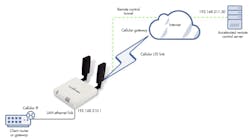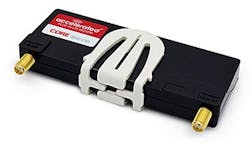Download this article in PDF format.
Before 3G and now 4G networks became a trusted source for failover and network backup, organizations relied on DSL, ISDN, or even T1 lines as secondary communication sources. Today, cellular networks are replacing these wired alternatives as they are extremely reliable and more than fast enough for the clear majority of use cases, from retail to critical infrastructure. The fifth generation of cellular technology promises to dramatically increase these capabilities, effectively making wireless communications the “go to” technology for an even greater variety of failover, private network, and backup applications.
Network outage is a billion-dollar problem, and annoyance for some but an absolute disaster for others whose business relies on the ability to have reliable, high-speed connection to the Internet. And today, this applies to almost every business, academic institution, government agency, and many others as well.
Estimates of network downtime costs range from an average of 324 hours a year to five times that or more depending on the source. Some companies, including supermarkets and retailers, report that at least one store will have downtime once a week, which multiplied by the number of brick-and-mortar stores in a large company, results in an uncomfortably large number. Cellular rather than wired backup solutions are increasingly becoming the way organizations keep their operations online and secure when the main network fails.
When the first early adopters began using cellular modems and routers as a secondary source of Internet access, there were few options available in the marketplace and perhaps surprisingly little interest among wireless carriers to create a category of service for this purpose. They essentially treated every wireless connection-- whether residential or commercial--as the same, with data caps and other impediments.
However, it didn’t take long before carriers got the message, and today AT&T and Verizon have dedicated services providing business solutions dedicated to redundant data management and disaster recovery. They also offer private networks dedicated to enterprise services rather than traditional cellular customers.
The basic cellular backup or failover scenario.
Sponsored Resources:
- New Concepts in Cellular Routers, Part 1 - Upgradeable Modems
- New Concepts in Cellular Routers, Part 2 - Deploying your Router
- 6330-MX Compact, High-Performance LTE 4G Router
Private cellular data networks are in effect new, as cellular data communications only became usable in a practical sense once 4G arrived and will almost certainly become more widespread in the future. Typically, targeted applications include industrial IoT and entities seeking to create their own enterprise-wide wireless communications networks.
Before this, the only private networks were based on Wi-Fi, which has significant limitations when compared to carrier-grade LTE networks. A private LTE network operates independently from the public Internet but still uses the carrier’s network and typically supports cloud-based services. It provides the advantage of controlling access to critical data administered through the wireless carrier. Routers and other hardware used on the network must meet the carrier’s specifications such as Verizon’s Open Development Verizon Private Networking certification.
There haven’t been any independent LTE networks because their cost was prohibitive, but the FCC’s creation of the Citizens Broadband Radio Service (CBRS) changes that, as almost any organization can operate within this frequency allocation. To no one’s surprise, LTE will be the predominant wireless access method. CBRS is just now moving forward and there are still some issues to be resolved, but it should provide another opportunity.
From an equipment perspective, there are many choices today for cellular routers and modems, nearly all of which are supported by software and other services by their manufacturers, creating an entire ecosystem for managing network of cellular devices. As every organization has different requirements, many of these manufacturers have created solutions that provide features either unique or vital to specific industries.
For example, Accelerated, a subsidiary of Digi International, provides a variety of routers, modems, and router-modem combos dedicated to the use of cellular networks for providing not just backup but primary connectivity. They’re small enough to be installed almost anywhere, which makes them very appealing for kiosks, ATMs, digital signage and a variety of other systems along with traditional enterprise and retail applications. They support every wireless carrier as well as communications protocols ranging from GSM through LTE Advanced Pro. Security is provided by AES and 3DES, IPSec, and other security tools.
They are supported by an out-of-band cellular remote manager that provides the ability to manage both remote devices and network equipment to provide almost instantaneous failover capability. The company also provides a product that provides out-of-band management for critical infrastructure including devices that use RS-232 communications, as well as servers, routers, firewalls, and other network equipment.
The company has also launched the CORE 1002-CM modem module that slides into an Accelerated LTE router, letting customers select the cellular network that best meets speed, budget, fallback-network, and other requirements. It supports LTE Advanced, standard LTE, and LTE with EV-DO fallback, as well as dual SIMs for automatically switching between different carriers. As new LTE technologies become available (such as features within the 5G umbrella), they will be integrated within new versions of the modem and replace the existing version in use rather than replacing the router itself.
Accelerated’s CORE 1002-CM modem module integrates within an Accelerated LTE router to allow new technology insertion without replacing the router.
The entire ecosystem is managed by the company’s cloud-based portal, aView (Accelerated View), which monitors the wireless data network and its connected devices, providing a centralized way to monitor and control LTE routers and modems, remote managers, gateways, and other connected devices. Any of these devices can be local or virtually anywhere as well as the cloud-based servers. Although the system is not fully autonomous, it dramatically reduces the need for staff for verification of network and power connections, troubleshooting, or even power-cycling devices.
Accelerated's cloud-based portal, aView, monitors the wireless data network and its connected devices.
In short, regardless of the application they’re used for, cellular modems, routers, and their management tools take advantage of the formidable capabilities of cellular networks that have become a match for their wired counterparts in speed, reliability, latency, and other metrics. It’s not unreasonable to predict that soon they will replace almost all wired backup solutions.
Sponsored Resources:
- New Concepts in Cellular Routers, Part 1 - Upgradeable Modems
- New Concepts in Cellular Routers, Part 2 - Deploying your Router
- 6330-MX Compact, High-Performance LTE 4G Router
Related Resources:



